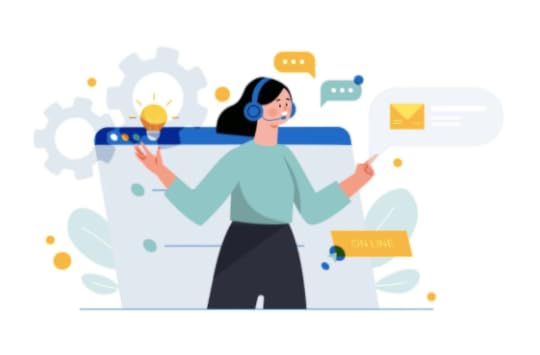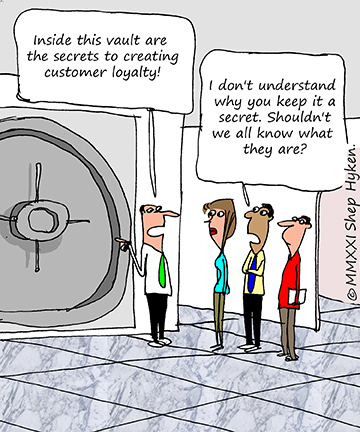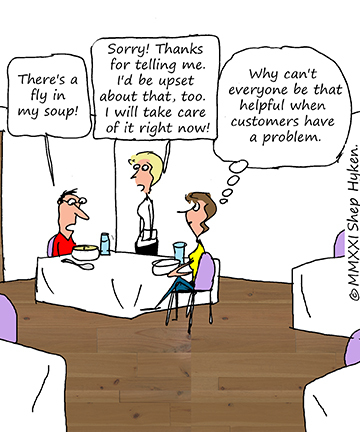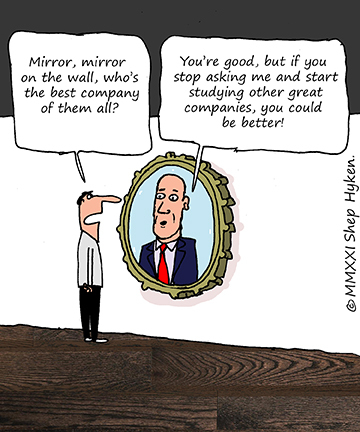Shep Hyken's Blog, page 76
October 15, 2021
Guest Post: 7 Benefits of Ticket Management System
Maulik Shah is the founder of DeskXpand, A full-fledged ticket management system that comes with the right tools to provide a seamless and cost-efficient customer experience. He shares 7 benefits that the support ticket system can provide for your business.

Want to support your help support team by simplifying the ticket process for them? Then installing a ticket management system is the best help you can offer because it helps your employees to track the progress, achievements, and even prioritizing tasks.
A robust ticket management system can reduce your desk employee’s work stress, promote work efficiency, enhance productivity, and improve ticket management strategy.
Here are the benefits that the support ticket system has to provide you: Track TimeOne of the best benefits of using ticket management software is its ability to track why times. Here, your goal should be to have a good average ticket response time. If the response time is not good, you need to know about the issue and take the necessary action to improve them.
Tracking ticket time helps you to measure your efficiency. Each time a new ticket opens, it starts a timer to see for how long they are open. By this, you will also be able to see which technicians are closing the most tickets. This allows you to see the productivity ratio to where training necessities lie and whether you require hiring more help desk support staff or maybe even eliminate some.
Solve ProblemsAnother benefit of ticket management is that you will solve problems that are being called in. You can see all of the tickets in an organized way. You can begin establishing a system where the help desk support team can distribute the tickets and then begin to solve the registered problems like:
Computer breakdowns Memory upgrades Network down Screen freezes Software complicationsThe problems may vary from user to user, day to day, or department to department. The software maintains a record of every solved problem so that you can compare them occasionally. It will be helpful to detect what problems are repeatedly occurring so you can take further action like upgrading computers or improving your network system.
CommunicationCommunication is crucial and critical within any business niche, and installing ticket management software allows you to communicate clearly with your employees. If you detect that some problems are occurring because of “user error,” then it may signify the need to improve and increase communication. Employees may require more training and lessons on the hardware or software they have access to or handle spam-related mails and avoid unauthorized website usage.
Setting PrioritiesSome tickets may come, which are a lot more critical than others. For instance, your help desk should know that it is more important to focus on a downed network than to reset the secretary’s password. And this software can help you to prioritize tasks.
The prioritization levels vary upon the kind of software that you opt for. You can set the prioritization on your own. Additionally, you can set some rules too for prioritizing the tickets automatically. For example, you can set a sequence where technical issue tickets should show up as first in priority, so the software will automatically put any technical queries on top of all.
You can also allow sending some “high priority” items to the managers directly so that they too can be aware of the problem and can track its progress.
OrganizingYour employees need your help to get them organized. You may hear plenty of help desk support staff saying that they experience headaches over the end of the day due to constantly pulling themselves in a million different directions. And this leads to longer ticket times and a lower level of productivity. Here, the software will keep them organized as they have a list of tickets to work on according to the priorities. They complete the list by going down the list throughout their shift. And then, when they arrive the next day, they can start at the top of the list again.
Support the BusinessThe reports that you will be able to obtain from the software will tell you about all of the different problems taking place by the user of any department. The reports enable the support of the business with more efficiency by learning how you can infuse money into the operations.
Here are some of the things that reports may help you to realize if you:
Need more staff Require newer computers Have issues with malware Reduce ExpendituresThe software can help you to cut down the expenditures. You can quickly find out where the most significant issues are present within your business. Additionally, a significant amount of your help desk support team spends more time helping the standard employees with the issues they should know how to solve. You can increase training sessions to improve productivity. And if you find that you can close tickets faster than usual, you can downsize your IT team and save a lot of money in labor.
Final WordsTicketing Management System assists you in finding and analyzing issues and identifies the root causes of problems that may be problematic for your business productivity. The system enables capturing and managing requests efficiently so that the authorities can pay more attention to solving issues rather than managing them.
Maulik Shah is the founder of DeskXpand, A full-fledged ticket management system that comes with the right tools to provide a seamless and cost-efficient customer experience. Maulik is a tech enthusiast and writes about the various aspects of the customer support platform.
 For more articles from Shep Hyken and his guest contributors go to customerserviceblog.com.
For more articles from Shep Hyken and his guest contributors go to customerserviceblog.com.
Read Shep’s latest Forbes article: Ask Seven Questions To Create Success In Tough And Uncertain Times
The post Guest Post: 7 Benefits of Ticket Management System appeared first on Shep Hyken.
October 13, 2021
The Secret To Customer Loyalty
 Okay, maybe it’s not the secret, but what I’m about to share with you is one of the secrets. Actually, three secrets.
Okay, maybe it’s not the secret, but what I’m about to share with you is one of the secrets. Actually, three secrets.
In the real estate world, the three keys to success are location, location, location. In this article, we can say that three secrets to creating and sustaining customer loyalty are communication, communication, communication. The way you communicate, what you communicate, and how often you communicate can create the experience that gives a customer the confidence to continue doing business with you.
So, with that in mind, here are three communication tips that will help drive customer loyalty and move them to say, “I’ll be back.”
Keep customers informed. Customers love information that gives them a sense of control. Think about placing an order with Amazon and immediately receiving an email that confirms the order is placed. Then you receive an update that the order has been shipped. Finally, you receive an email that informs you the package was delivered. Sometimes there is a picture of the package next to your door. Whether you’re sending out emails, text messages, calling the customer, or using any other form of communication, keeping customers informed is actually creating confidence that all is going according to plan. Customers love that! Stalk your customers on social media. Okay, stalk is a strong word, but I wanted to grab your attention. Perhaps a better way to put it is to track your customers on social media. This is especially powerful for B2B businesses, but almost any type of business that has one-on-one relationships with customers can use this tip. Set up a Google Alert for your best customers. The customer could be an individual or a company. You’ll be informed of any news that is published about them. Imagine that your customer received a promotion, or the company received an award, and you were one of the first to congratulate them. Go old school and call your customer. When is the last time you picked up the phone and called a customer with no agenda other than to say hello and see how they were doing? Even if all you can do is leave a voice mail, it lets the customer know you are thinking of them. The secret to the success of this simple idea is to have no agenda other than keeping in touch. In other words, don’t bring up business. Don’t tell them about the new product you have. Save that for a sales call. This is just a touchpoint with your customer that is all about them. Of course, the customer may ask you something related to business, but that’s on them, not you.Of course, there are many more ways to communicate with your customers. If you have a favorite tip, technique, or “secret,” please take a moment to share it below.
Shep Hyken is a customer service expert, keynote speaker, and New York Times, bestselling business author. For information on The Customer Focus customer service training programs, go to www.thecustomerfocus.com. Follow on Twitter: @Hyken
customer service training programs, go to www.thecustomerfocus.com. Follow on Twitter: @Hyken
(Copyright © MMXXI, Shep Hyken)
The post The Secret To Customer Loyalty appeared first on Shep Hyken.
October 12, 2021
Amazing Business Radio: Jenn Lim
 Beyond Happiness
Beyond HappinessHow Authentic Leaders Lead with Happiness and Humanity
Shep Hyken interviews Jenn Lim, CEO of Delivering Happiness and the author of Beyond Happiness: How Authentic Leaders Prioritize Purpose and People for Growth and Impact. They discuss how leaders can adapt to the new workplace by being authentic and aligned with their purpose.







 Top Takeaways:As leaders, we need to get more real with ourselves. We want to celebrate the highs in our lives but we also need to recognize our lows and our blind spots. Then, we need to allow the people that we lead to do that, too.In the past year, we have experienced the “Great Resignation” where a record number of 4 million employees, in the US alone, quit their jobs in April. The integration of work and life in a way that has never been experienced before has led people to evaluate what is most important to them and how they can align their lives with it.The experiences that we have had in the past couple of years have prompted many to ask the questions like: How can I align myself and my life with what is most important to me? What are the things that I need to work on and be aware of so I can be a more whole person at work and in life?When employees are unhappy and start leaving the company, leaders can learn so much by asking them why and actually listening. Have an open and honest dialogue as to where your employees are at work and in life.Authenticity goes into the wholeness of a person. Leaders must respect who employees are as human beings beyond their skills and what they bring to the table.The more employees see that they are respected inside and outside their specific role and title, the more they want to be productive, engaged, and loyal.Quotes:
Top Takeaways:As leaders, we need to get more real with ourselves. We want to celebrate the highs in our lives but we also need to recognize our lows and our blind spots. Then, we need to allow the people that we lead to do that, too.In the past year, we have experienced the “Great Resignation” where a record number of 4 million employees, in the US alone, quit their jobs in April. The integration of work and life in a way that has never been experienced before has led people to evaluate what is most important to them and how they can align their lives with it.The experiences that we have had in the past couple of years have prompted many to ask the questions like: How can I align myself and my life with what is most important to me? What are the things that I need to work on and be aware of so I can be a more whole person at work and in life?When employees are unhappy and start leaving the company, leaders can learn so much by asking them why and actually listening. Have an open and honest dialogue as to where your employees are at work and in life.Authenticity goes into the wholeness of a person. Leaders must respect who employees are as human beings beyond their skills and what they bring to the table.The more employees see that they are respected inside and outside their specific role and title, the more they want to be productive, engaged, and loyal.Quotes:“Happier employees equals happier customers equals more profitable and sustainable business.”
“With all the changes around us, there is a bigger need for leaders to be authentic. This is how a strong, vibrant, and sustainable culture is created.”
“When you’re being authentic, you are acting like a leader. You can be a leader at work and in life if you choose to be, no matter what role or title you have.”
“Having a higher purpose is the most sustainable form of happiness.”
“As leaders, our job is to take care of others. But the reality is, you need to nurture your own greenhouse first so that you can grow the greenhouses around you.”
About:Jenn Lim is the CEO of Delivering Happiness, a company she co-founded with Tony Hsieh of Zappos.com to create happier company cultures for a more profitable and sustainable approach to business. Jenn’s mission is to teach businesses how to create workplaces—led with happiness and humanity—that generate more profit, sustain all people at every level of the organization, and share how we can make an impact by being true to our authentic selves.
Shep Hyken is a customer service and experience expert, New York Times bestselling author, award-winning keynote speaker, and your host of Amazing Business Radio.
This episode of Amazing Business Radio with Shep Hyken answers the following questions … and more:
What is an authentic leader?How can leaders create a sustainable culture?How can leaders keep their employees from leaving?Who can become leaders at work?How can leaders become more aligned with their purpose?The post Amazing Business Radio: Jenn Lim appeared first on Shep Hyken.
October 11, 2021
5 Top Customer Service Articles of the Week 10-11-2021
Each week I read many customer service and customer experience articles from various resources. Here are my top five picks from last week. I have added my comment about each article and would like to hear what you think too.
4 Ways to Level Up Your Customer Service in 2021 by Reuben Yonatan(Fast Company) Providing exceptional customer service is a tried and tested way for brands to stand out and succeed. Here are the four best ways to make sure your customer service is top-notch in 2021.
My Comment: This article hits on some of the basics of a great customer experience. And, it’s not about being “over-the-top,” but simply doing what customers expect. The topics covered include quick response times, providing self-service options, different ways customers can communicate with you (phone, email, chat, text, etc.), and solving the problem on the first call (known as first call resolution). What customers don’t want any or all of that?
3 Key Signs of Customer Experience Maturity by Brandon Vigliarolo(TechRepublic) A Zendesk report found a series of commonalities among companies it calls CX champions. Do your organization’s CX goals line up with those of CX-maturity leaders?
My Comment: Is customer service getting better? Some would argue and say it’s not, but this article features Zendesk’s State of Customer Experience (CX) Maturity Report, which breaks companies down into four tiers of customer experience maturity: champions, risers, emerging organizations, and starters. What’s interesting is that the Champions category more than doubled from 6% to 14%, which tells me more companies see the benefit of customer experience. Check out the article and the report and see if your organization aligns with what it takes to be a CX Champion.
Are Hotel Loyalty and Rewards Programs Enough to Keep Customers Loyal to the Brand? by Max Starkov(Hospitality Net) The best demonstration of brand loyalty in hospitality and travel, in general, is the share of repeat business. Travel consumers are buried under an avalanche of options and offers, and if they repeatedly choose your brand over the competing alternatives, obviously your brand has an appeal above and beyond the competition. This appeal is a result of the perceived value proposition of your brand and the travel consumer’s emotional attachment to your brand.
My Comment: If you’ve been following me, you know I’m a big fan of all companies having a hospitality mentality. We can learn so much from the hospitality industry. This particular learning opportunity is in the form of an article that discusses hotel loyalty and rewards programs. There are some interesting stats and facts that prove how important some of these programs are. While the numbers don’t necessarily apply to all businesses, the general idea behind them does. It’s important to note that these loyalty programs aren’t making customers loyal, but they are making them come back. While loyalty and repeat business may not be exactly the same, nobody should complain when your marketing efforts get customers to come back again and again.
Intentionally Creating a Culture that Prioritizes Customer Experience by Martha Kesler(Nextgov) Culture begins to shift when new behaviors are established that generate meaningful results, and wins are loudly, publicly celebrated.
My Comment: We now move into one of my favorite topics, creating the right customer-focused culture. I’ve said this many times before: Customer service is not a department. It’s a philosophy to be embraced by everyone in an organization. Same for CX. It’s more than a strategy. It’s baked into the culture. This article has an interesting process on how to define the desired culture and what it takes to bring it to life.
What Makes an Optimal Customer Experience in 2021? by Brandi Marcene(Atlanta Small Business Network) The focus of most website owners is to improve brand positioning and boost traffic. You’d be surprised to see how many businesses often overlook the elements that lead to optimal customer experience. Since there’s no specific formula to improve customer experience online, many businesses tend to adapt generic tactics that put off existing and potential customers.
My Comment: Just reading the title was intrigued me to want to read the rest of the article. Here’s a great stat from the article. The average potential revenue lost as a result of not offering a positive, consistent, and brand-relevant customer experience is 21%. That’s the average. It could be less or more, depending on your company and how you handle your customers. There are more stats, and they are followed with several ideas on how to create that optimal customer experience.
BONUSTop 5 Ways to Achieve Superior Customer Service by Uniphore(Uniphore) To understand what superior customer service looks like, we decided to ask the experts. We asked two leading customer service experts and members of Uniphore’s customer service teams for their advice on how to delight customers.
My Comment: I like this article, not just because it includes my interview, but it shared an idea that I’ve been preaching for years. The customer is NOT always right, but they are always the customer. The author’s spin on this is, “The customer always comes first, but that doesn’t mean they are always right.” It’s important that everyone in your organization knows and understands what this means. If you like this idea, you’ll love the rest of the article.
Shep Hyken[image error] is a customer service expert, professional speaker, and New York Times bestselling business author. Go to The Customer Focus to learn more about our customer service training programs. Follow on Twitter: @Hyken
to learn more about our customer service training programs. Follow on Twitter: @Hyken
The post 5 Top Customer Service Articles of the Week 10-11-2021 appeared first on Shep Hyken.
October 8, 2021
Guest Post: 4 Customer Service Best Practices for Your Subscription Business
Doug Liantonio is the Marketing Outreach Analyst at Gravy Solutions, a company that helps subscription-based businesses recover failed payments and retain customers. He shares four customer service methods for your subscription-based business that will help you boost your reputation, increase customer satisfaction, and improve overall business health.
From afar, customer service seems like it should be simple. Just answer any questions your customers may have. Right?
With any experience in customer service, you understand it’s far from simple — especially as the business grows and the number of customers increases.
While trying to keep up with the demand, it can be easy to fall into customer service methods that aren’t effective.
But because your customer service hugely impacts brand reputation, it should be treated with intentionality and delicacy that reflects that. Here are four customer service methods for your subscription-based business that will help you boost your reputation, increase customer satisfaction, and improve overall business health:
Lead with EmpathyBehind every subscription is a person.
As a business owner, it’s shockingly easy to forget that. You start looking at revenue and number of subscribers and forget that every single one of those data points is influenced by the people buying from your brand.
As a customer service agent, it’s easy to fall into the trap of answered calls and answered chat tickets.
But they’re people.
That’s why it’s vital to lead with empathy when providing effective customer service. Whether someone uses a negative or positive tone in speaking with you, remember they’re reaching out because they’re experiencing a problem, they’re confused about how to do something, or they need another form of help.
You have the opportunity to hear their unique situation and offer them an empathetic solution — even if their tone isn’t so nice.
People have bad days. People get frustrated. No matter what the circumstances are, always offer sympathetic, human-first customer service.
Ditch AutomationBecause customer service works best when centered on empathy, automation shouldn’t be your main form of customer service. In fact, it should be a very small part.
Based on research done by Gravy, 92.2% of customers reported satisfaction from speaking with a human, while only 45.18% reported satisfaction from talking to a bot.
Why? Well, in part, because of empathy. Robots can’t understand people the way other humans do. They don’t and can’t show the same care toward extenuating circumstances a customer may be facing.
For that reason, while automation can be a cost-effective and simpler customer service method for companies, it’s costly in the long term.
Chances are you’re losing customers due to unresolved or poorly resolved complaints and the low customer satisfaction associated with bots.
With that being said, opt to only use automation where absolutely necessary. It will make sense to send a certain number of automated emails and messages, but that shouldn’t be your main method of communicating with customers looking for solutions.
Make Note of FeedbackReceiving negative customer queries can be tough on morale and drain your energy. However, you can turn these negative communications into positives.
Whenever you receive feedback from a customer (good or bad — but especially when it’s bad), make note of it.
Over time, you’ll likely start to see common themes among these comments. When a trend emerges in your customer feedback, leverage this data to make improvements to your product or service.
Analyzing this feedback creates the perfect opportunity to actually improve your business as well as customer satisfaction.
In other words, a dissatisfied customer now allows you to make improvements for a number of happy customers in the future.
Don’t let this opportunity go to waste.
Be AccessibleEvery time a customer reaches out to your team with a question or concern it’s an opportunity for you to build trust in your company, improve customer satisfaction, and possibly even prevent customer churn.
That’s why it’s critical reaching your customer support team is easy and accessible. If you offer customer service via the phone, don’t leave your customer on hold for 20 minutes. For emails, respond quicker than 48 hours.
To make finding the answers your customers need even easier, provide an FAQ page in the support section of your website. This will hopefully help free up some of your team’s bandwidth by solving issues before a customer even needs to contact you. Plus, the customer will be pleased finding an answer was a quick and simple process.
If a customer can’t reach a person to speak to about their issue, it builds up distrust and resentment. When this happens and a customer doesn’t feel cared for, you’ll likely lose their business either immediately or down the line.
ConclusionYour customer service greatly contributes to the overall health of your business. When you’re failing to address customer concerns and provide an open line of communication, you risk losing customers due to dissatisfaction.
That’s why leveraging empathy, reducing automated communication in favor of human-to-human contact, accepting and implementing feedback, as well as being accessible will greatly improve your subscription company.
Doug Liantonio is the Marketing Outreach Analyst at Gravy Solutions, a company that helps subscription-based businesses recover failed payments and retain customers.
 For more articles from Shep Hyken and his guest contributors go to customerserviceblog.com.
For more articles from Shep Hyken and his guest contributors go to customerserviceblog.com.
Read Shep’s latest Forbes article: Choose Your Words Wisely: The Right Words Matter!
The post Guest Post: 4 Customer Service Best Practices for Your Subscription Business appeared first on Shep Hyken.
October 6, 2021
The Five Best Things to Say to an Angry or Upset Customer
 I was recently interviewed by Mario Martinez on his Modern Selling podcast. He shared a story about how he emailed the CEO of a company, and in an incredibly short amount of time, his phone rang, and you can guess who it was … the CEO.
I was recently interviewed by Mario Martinez on his Modern Selling podcast. He shared a story about how he emailed the CEO of a company, and in an incredibly short amount of time, his phone rang, and you can guess who it was … the CEO.
In a state of shock, instead of launching into the reason for the complaint email, my friend asked him, “How are you?”
The CEO said, “I’m not well. That’s because you’re not well.” He was referring to the complaint and how my friend wasn’t happy with his company’s product.
That made me start thinking about the best ways to begin a conversation with a complaining or upset customer. Of course, there may be a few pleasantries to welcome a customer into the conversation. Then, what is said next is what’s important. So, here are a few lines that customers love to hear. They show concern, empathy, and create a sense of confidence. Done right, they help renew the customer’s desire to continue the business relationship.
“Sorry!” Of course, any sentence that starts with a genuine apology is a good way to respond to the complaining customer. There are many ways to say, “I’m sorry.” “I can understand why you’re upset. I would be too if that happened to me.” This is a great empathy statement. It’s a way of saying, “You’re right,” and it shows you are relating to the customer. “I’m glad you called. My name is ____ (fill in the blank), and I’m here to take care of you.” This indicates some level of ownership. “We need to do something about this right away.” This creates a sense of immediacy. If there is a way to resolve the issue in that call, you’re on your way to complaint resolution success. At a minimum, discuss the timing of the resolution. “Let’s work through this together.” This statement makes a connection with the customer. They become a contributor to the solution. The customer may even feel as if “they have a friend on the inside.”If any promises or commitments are made, such as, “You should hear back from us by the end of the day,” be sure to follow through. Otherwise, all of the efforts will have gone to waste. And, once the conversation is coming to a close, don’t forget to say, “Thank you.” What started as a Moment of Misery for the customer is ending as a Moment of Magic®. Be sure customers know how much you appreciate their business, and how you look forward to serving them again.
Shep Hyken is a customer service expert, keynote speaker, and New York Times, bestselling business author. For information on The Customer Focus customer service training programs, go to www.thecustomerfocus.com. Follow on Twitter: @Hyken
customer service training programs, go to www.thecustomerfocus.com. Follow on Twitter: @Hyken
(Copyright © MMXXI, Shep Hyken)
The post The Five Best Things to Say to an Angry or Upset Customer appeared first on Shep Hyken.
October 5, 2021
Amazing Business Radio: Daniel Fallmann
 A Holistic View of the Customer
A Holistic View of the CustomerEmpowering Customer Service Agents with Knowledge
Shep Hyken interviews Daniel Fallmann, founder of Mindbreeze, a tool that helps companies capture a holistic view of their customers’ data. They discuss how organizations can arm their frontline customer service professionals with the technology that can help them offer better customer service.







 Top Takeaways:The lack of information on a specific customer or product is the key problem for most businesses in every industry. Since the data is often scattered across many platforms, it is not readily available to customer service professionals when they need it.Customer service professionals need a one-stop shop where they can have a holistic view of the customer’s information coming from different platforms and departments.Companies need to equip customer service agents with knowledge of the product as well as knowledge of the customer – who they are, what they search for on your website, and what their questions or challenges are.Having the technology to access the right information reduces ticket escalation. But, when ticket escalations do happen, it also helps customer service agents identify the experts inside the organization to help with non-trivial customer issues.You can predict what the problem is because of customer behavior. For example, what they are searching for on your website? Are they watching your videos or webinars? What issues are they calling in with? Knowing that information can help you come up with implicit problem-solving mechanisms, knowledge base articles, and automatic routines that make sure the problems do not ever occur, to begin with.Quotes:
Top Takeaways:The lack of information on a specific customer or product is the key problem for most businesses in every industry. Since the data is often scattered across many platforms, it is not readily available to customer service professionals when they need it.Customer service professionals need a one-stop shop where they can have a holistic view of the customer’s information coming from different platforms and departments.Companies need to equip customer service agents with knowledge of the product as well as knowledge of the customer – who they are, what they search for on your website, and what their questions or challenges are.Having the technology to access the right information reduces ticket escalation. But, when ticket escalations do happen, it also helps customer service agents identify the experts inside the organization to help with non-trivial customer issues.You can predict what the problem is because of customer behavior. For example, what they are searching for on your website? Are they watching your videos or webinars? What issues are they calling in with? Knowing that information can help you come up with implicit problem-solving mechanisms, knowledge base articles, and automatic routines that make sure the problems do not ever occur, to begin with.Quotes:“Customers today have an “I need it now” approach. Customer service professionals need to know how to easily access information for them to understand the context of the customer’s concerns.”
“The ease of the customer service representative’s job is a great indication of the customer satisfaction levels. Companies need to arm their frontline customer service teams with technology that empowers them to offer a better customer experience.”
“The right technology can help companies anticipate what issues and concerns their customers will be coming to them with. This empowers customer service representatives to give customers exactly what they need when they need it.”
“Customer engagement is not a one-shot problem-solving action; it is a proactive and continuous process.”
“Companies can use AI to look for patterns in customer behavior to anticipate issues and generate solutions before problems even occur.”
About:Daniel Fallmann founded Mindbreeze in 2005 at the age of 23, after he finished his studies in computer science. As Mindbreeze’s CEO he is a living example of high quality and innovation standards. His passion for enterprise search and machine learning in a big data environment fascinated not only the Mindbreeze employees but also their customers.
Shep Hyken is a customer service and experience expert, New York Times bestselling author, award-winning keynote speaker, and your host of Amazing Business Radio.
This episode of Amazing Business Radio with Shep Hyken answers the following questions … and more:
What does a holistic view of the customer mean?How can AI predict customer behavior?How can companies empower their customer service representatives?What is the indicator of customer satisfaction levels?How can companies anticipate customer questions and issues?The post Amazing Business Radio: Daniel Fallmann appeared first on Shep Hyken.
October 4, 2021
5 Top Customer Service Articles of the Week 10-4-2021
Each week I read many customer service and customer experience articles from various resources. Here are my top five picks from last week. I have added my comment about each article and would like to hear what you think too.
7 Techniques That Are Key to Customer Retention Today by John Hall(Inc. Magazine) It’s a business axiom that holding on to existing customers is more lucrative than acquiring new ones. These 7 techniques will make it as easily done as said.
My Comment: Returning customers are more profitable, not just because they return. Because they spend more on average per visit than one-time or once-in-a-while customers. And a repeat customer could mean a loyal customer, someone who not only returns but also evangelizes your brand or company. John Hall is a marketing and CX expert, and he shares seven ways to get customers to come back. Pay close attention to the first tip, which is proactive customer service. This is one of my favorite ways to create confidence and trust with a customer.
7 Tips for Increasing Customer Lifetime Value: How to Keep Your Customers Happy by Wise Marketer Staff(The Wise Marketer) Over their lifetime, customers will spend a certain amount on a company’s goods or services, which is referred to as their customer lifetime value (CLV). Increasing their CLV, meaning keeping your existing customers happy, is an essential strategy for any business.
My Comment: As long as we’re talking about customer retention, let’s talk about lifetime value. And is it a coincidence that this article also has seven tips? Seriously, repeat customers spend 67% more than new customers. That number should be enough of an incentive that motivates you to provide an experience that gets them to come back. The article includes an infographic that summarizes the points.
17 Key Customer Service Skills [List & Resume Examples] by Kazimierz Rajnerowicz(Tidio) It is clear that you can’t have happy customers without offering amazing support. Period. But which customer service skills translate into great customer service experiences? Is good service more than solving a customer’s issue?
My Comment: I’m trying to stay with a theme of “Seven” this week. We’ve had seven tips for retention, seven tips to lifetime value. Now it’s time for not seven, but seventeen customer service skills tips! This is a very robust article, with lots of great content. There’s something here for everyone.
How to Build Customer Loyalty (7 Proven Ways) by Syed Balkhi(CustomerThink) Did you know that returning customers spend around 70% more money on products when compared to first-time customers? Customer loyalty is customers’ likelihood of doing repeat business with your company, which is crucial to create a successful business.
My Comment: Another article with seven tips, and this one focuses on loyalty. If you go back to John Hall’s article (Top Five #1 this week), his focus is on retention, which is very similar to loyalty. However, these tips are different. It starts with something pretty simple, yet powerful: Give Exceptional Customer Service. Sounds like common sense, but we all know from our own experiences that it’s not as common as it should be.
8 Rules for the Perfect Customer Service [INFOGRAPHIC] by Alex Tereshchenko(Helpware) A+ customer service is paramount to any successful business. However, most businesses do not have a concrete plan on how to achieve top-notch customer service, which is why we decided to provide you with eight “must-haves” if you want to provide outstanding service to your customers. We call it the “Customer Service Bill of Rights.”
My Comment: Before you say, “Shep, there are eight tips here, not seven,” you’ll have to read the article. While the title has “8 Rules,” there is an infographic at the end of the article titled The Customer Service Manifesto, and it includes, you guessed it, SEVEN steps to win over customers and clients.
Shep Hyken[image error] is a customer service expert, professional speaker, and New York Times bestselling business author. Go to The Customer Focus to learn more about our customer service training programs. Follow on Twitter: @Hyken
to learn more about our customer service training programs. Follow on Twitter: @Hyken
The post 5 Top Customer Service Articles of the Week 10-4-2021 appeared first on Shep Hyken.
October 1, 2021
Guest Post: Customer Service Automation: A Quick Beginner’s Guide
This week we feature an article by Jason Grills, Customer Support Expert at ProProfs, a company that provides software that empowers organizations to deliver happiness to their customers and employees. He writes about what automated customer service can do for your business.
Customer service automation isn’t a new deal for businesses. It has built a stable reputation for itself in the past decade.
Yet we see only 33% of contact centers investing in automation tech systems and robotics.
One of the possible reasons for such lower adoption rates is not exploring what automation systems can do for their business. And those who might be interested in investing in such technologies are still lagging due to serious contemplation.
Understanding the possible dilemma, we’ve curated a quick guide for businesses. This guide briefly touches upon the concept of service automation, why it is so popular, why your business needs it now, and the best ways to implement it in your business.
Without further delay, let’s dive in!
Understanding the Automated Customer Service From ScratchTo overcome your doubts on whether customer service automation is truly meant for your business or not, you need to start from the basics.
What is Automated Customer Service?In simple words, customer service automation is an alternative to traditional customer service. You no longer need to make your customers and prospects wait in queues to get an answer to their questions.
Automated customer service systems like IVR, chatbots and even knowledge management systems can help you assist customers even when your agents aren’t online.
It helps your business to become a 24×7 service provider. The set of technologies to automate customer service enables your business to reduce agent involvement at every support stage. This helps them focus on more crucial tasks and avoid burnout.
An Insight: What Makes Automated Customer Service System Popular Among BusinessesIf you ask us what makes customer service automation popular among businesses, then here’s what we’ll say.
It is one of the best ways to avoid human errors!
As humans, we are prone to making mistakes. However, we can’t give that excuse as a business to customers. With automation tools like IVR and chatbot, you can help customers reach the right agent, therefore helping them avoid repeating themselves multiple times. You can send error-free messages during an ongoing live chat conversation as well. It is also a great way to maintain a consistent tone with all the customers.
It makes 24×7 support a reality for your business.
Let’s not deny that support automation also helps your business meet target audience and existing customers at their preferred timings. Yes, some customers can have support needs at odd hours. And just because they wish to reach out at your non-working hours shouldn’t mean they should leave without a solution. Tools like a knowledge base and chatbot help you provide instant answers to customers and ensure they return to your brand the next time.
On top of that, customer service automation also reduces multiple touchpoints in the support process!
There are times (often frequently) when customers want an immediate answer to their questions. That’s one time they wouldn’t like to be sent from one customer support agent to another. However, automation tools can help your customers avoid annoying elevator music during wait times. They will route your customers to the right agent immediately. What’s more, automation tools will also help them resolve their questions if they are frequently asked questions.
Due to these factors, we strongly believe that automated customer service has increasingly become popular among business owners and is here to stay. Such benefits not only help them skyrocket customer satisfaction but also retain these satisfied customers in the long run.
Why Your Business Needs to Switch to Automated Customer ServiceIf popular reasons haven’t strengthened your decision on whether to switch to an automated customer service approach or not, then these three rational grounds should.
You need to save time.
And this isn’t just applicable to your business. Your customers are people who take time out of their busy schedules to get in touch with your business. With automated customer support tools in place, you can make sure you save your customers time and yours too by helping them reach the right department for support. It would allow you to close a ticket, chat, or even a call faster and help your agents move on to the next customer.
Your agents save multiple efforts.
With the right support automation system, your agents can avoid typing the same answers for commonly asked questions. Their effort to manually route customers to the right agent can also be saved. And let’s not skip over the fact that automation improves response time effortlessly. Your agents can become more productive and handle more customers satisfactorily.
You save money, period.
Saving time and effort does not necessarily equate to saving money. But agents get to focus and resolve complex situations as commonly asked questions are taken care of by automated tools like chatbots and knowledge base. This helps you reduce your efforts to hire more agents for your support process. This way, you get to reduce your efforts on the hiring process and save money.
These three grounds are crucial to any business owner. And if automated customer service tools help you benefit on all grounds, then this is the right fit for your business. Hoping that these convince you to venture into automated customer service, we now proceed to explore the best ways it can be adopted by your business and reap the best benefits.
Best Practices: How to Implement Customer Service Automation to Your BusinessWhen you see implementation suggestions for automated tools, you realize the type of tool you need to add to your service stack in the first place. While that’s one of the prominent motives, we also intend to help you learn how automated tools can be implemented the right way. Here’s a list of five suggestions that we hope helps you out.
Work on an Empathetic Conversational ChatbotWho said a chatbot can’t be empathetic. True, a chatbot needs to be more direct when it comes to order status or simply generating a ticket. But adding a tone of empathy or gratitude towards the customer can leave a good impression on them.
But how do you go about this?
If your chatbot builder is based on drag and drop technology, then you need to add phrases like “I’m sorry for the inconvenience caused” or “Let me route you to an agent” or even better “I hope you have a great day!”. These phrases will reduce the robotic tone and make the conversational experience more delightful.
But in case your chatbot software works on AI technology, then you can improve its response quality after testing it several times.
Develop a Well-Thought-Out Knowledge BaseA knowledge base is all your business needs to answer frequently asked questions. Simply work on building a well-thought-out knowledge repository. Understand the frequent queries your support agents receive via call, live chat, or even via a support ticket and make a list. It will help you get a head start to build quality self-help articles for your knowledge center.
You may ask – How to make them visible on our website?
You can start by adding your knowledge repository in the primary navigation as ‘Help’. Integrating it into your live chat and showcasing relevant articles for the page is another way to help customers get instant answers. Other than that, you can also add relevant help article links related to a page in your page footer. With these tactics, you can bring your customers one step closer to the solution.
Automate Your Ticket RoutingFrom building team efficiency to never missing out on support requests, a help desk ticketing system does it all. However, merely adding it to your customer service stack won’t help you automate your support process. You need to set up advanced ticket routing settings to make sure no ticket goes unanswered.
Here’s what you can do.
To assign tickets to agents, you can enable the round-robin system that automates this process without asking the admin to get involved. Other than that, you can also opt for skill-based routing. This will enable you to answer tickets faster and improve customer experience as well.
Create Canned Response TemplatesIt can be difficult to automate conversations for your agents when it comes to repetitive questions and phrases. It becomes more challenging to type the same responses when they are managing multiple conversations simultaneously.
To tackle such situations, you can create canned responses that help you automate the conversation experience for your agents. They can help agents while responding to a ticket or a question during an ongoing chat. This will assist them in reducing their response time and make sure that a conversation is closed faster with satisfied customers.
Opt for IVR to Automate Phone Support ProcessBusinesses heavily rely on phone support for interaction with customers. But when you face situations like the pandemic, you are likely to come across more panicked customers. It becomes challenging to manage all the incoming calls efficiently because your customers will have more questions to ask than ever before!
Harvard Business Review , in one of their reports, shares how an AI analysis of more than 1 million customer service calls showed a dramatic increase in customer anxiety and frustrations, and reps struggle to respond effectively.
But when you bring the right IVR system into the picture, you can ensure that customer support agents get ample time to process and respond to customer questions. This technology helps you capture a good amount of information on customers and what help they need. Call center owners can find this even more fruitful and enable them to streamline incoming support calls and assist customers in reaching the right agent who can offer a solution to them faster.
The Need of the Hour: Customer Support AutomationCustomer service automation is one of the best ways to ensure your business improves in terms of response time and provides a faster solution. However, not all businesses have integrated tools that could help them automate their customer service process.
To help them understand what automated customer service can do for them and how it can be implemented for their business, we created this beginner’s guide. We hope this guide helps businesses understand the worth of customer service automation, how it can help them, and the best way to implement it in the most efficient way possible.
Jason Grills is a Sr. Technical Writer currently associated with ProProfs Chat. He enjoys writing about emerging customer support products, trends in the customer support industry, and the financial impacts of using such tools. In his spare time, Jason likes traveling extensively to learn about new cultures and traditions.
 For more articles from Shep Hyken and his guest contributors go to customerserviceblog.com.
For more articles from Shep Hyken and his guest contributors go to customerserviceblog.com.
Read Shep’s latest Forbes article: You’re Terminated: Why Customers Stop Doing Business With You
The post Guest Post: Customer Service Automation: A Quick Beginner’s Guide appeared first on Shep Hyken.
September 29, 2021
Best in Class Versus Best in Industry
 Here is an interesting idea. Most businesses are competitive. They want to be better than their competition. Sometimes they try to out-service their competition. Sometimes they lower their prices to beat their competition. The point is that they are only looking at the competition. What if they looked beyond the competition? What if they looked at the world?
Here is an interesting idea. Most businesses are competitive. They want to be better than their competition. Sometimes they try to out-service their competition. Sometimes they lower their prices to beat their competition. The point is that they are only looking at the competition. What if they looked beyond the competition? What if they looked at the world?
One of my favorite companies to write about is Ace Hardware. I even wrote a book, Amaze Every Customer Every Time, in which I used Ace as the role model example throughout the entire book. It is a perfect example of this concept. First, Ace wanted to be the best of all hardware and home improvement stores. It accomplished that and has received numerous JD Power awards to prove it. But that wasn’t enough!
Ace Hardware stores didn’t stop with being world-class in the home improvement industry. The company wanted to be known as a world-class retailer. They wanted to go beyond their own industry. And they did. They became so good that other companies, completely unrelated to the hardware and home improvement industry, wanted to learn their secrets.
Other brands have gone down this path. Disney Institute teaches the Disney way in the form of courses on customer service and experience, leadership, and more. The Ritz-Carlton has a team of trainers that companies hire to learn the secrets of creating world-class hospitality and service. Zappos.com has its Delivering Happiness programs. All of these are iconic brands that teach how they do what they do so well.
But you don’t have to be a world-renowned brand to be paid to teach the inside secrets of a company’s success. You most likely haven’t heard of Barry-Wehmiller, a conglomerate of companies, primarily in the manufacturing business. This company has built a reputation for excellence. Bob Chapman, its chairman, and CEO, has a simple formula. Take a great business and a profound care for people and watch great things happen.
Chapman and his team have done such a good job of this that they are in demand to teach others how to do the same. The result is that they are teaching other companies, inside and outside of their industry. They are not only best in industry, but best in class.
You’ve heard the expression, “Think outside the box.” I now want you to think outside your industry. Think about what it takes to be world-class. That’s what the best companies are doing, and you can do it too!
Shep Hyken is a customer service expert, keynote speaker, and New York Times, bestselling business author. For information on The Customer Focus customer service training programs, go to www.thecustomerfocus.com. Follow on Twitter: @Hyken
customer service training programs, go to www.thecustomerfocus.com. Follow on Twitter: @Hyken
(Copyright © MMXXI, Shep Hyken)
The post Best in Class Versus Best in Industry appeared first on Shep Hyken.



